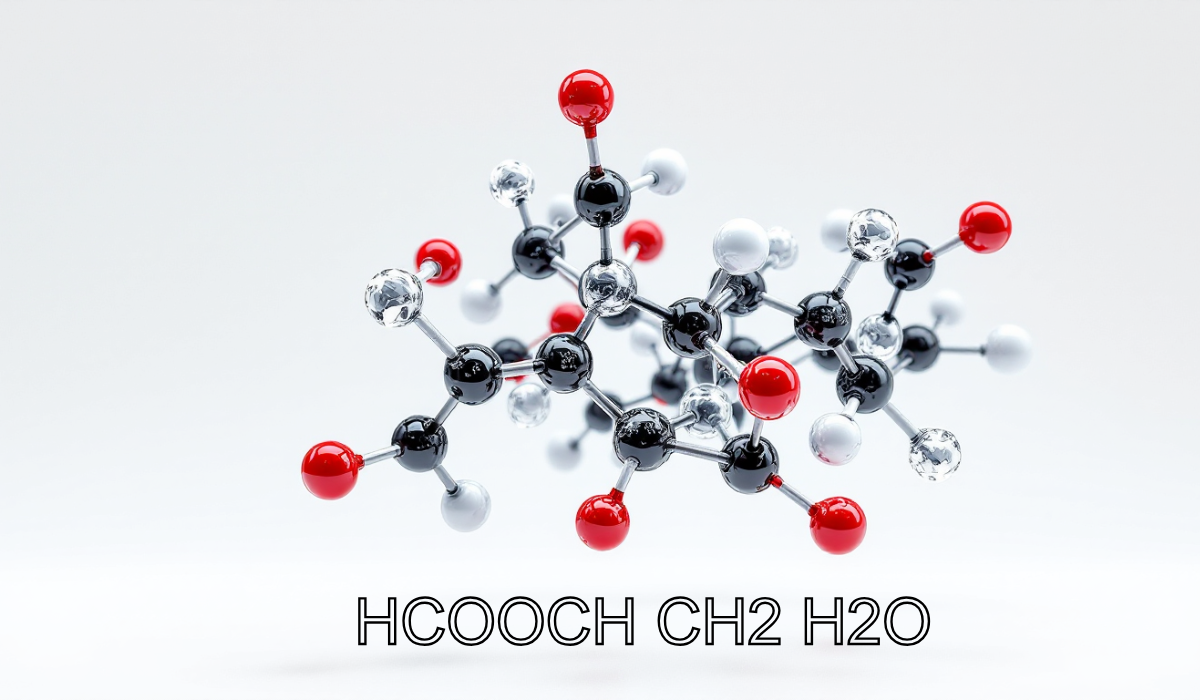In the vast universe of organic chemistry, few compounds bridge the gap between laboratory innovation and real-world impact as elegantly as HCOOCH CH H2O. Often overshadowed by more well-known molecules, this ester-based compound is quietly revolutionizing industries ranging from sustainable agriculture to advanced pharmaceuticals. But what makes it so special? Let’s embark on a journey to unravel its secrets, explore its versatility, and envision its role in shaping a greener future.
Decoding HCOOCH CH2 H2O: Breaking Down the Formula
At its core, HCOOCH CH2 H2O is a hybrid molecule born from the marriage of formic acid (HCOOH) and methanol (CH₃OH), with a methylene group (CH₂) and water (H₂O) adding unique functionality. Here’s a closer look:
- HCOO⁻ (Formate Group): Derived from formic acid, this group is a powerhouse in organic synthesis, enabling reactions like esterification and hydrolysis.
- CH₂ (Methylene Bridge): Acts as a molecular “backbone,” enhancing stability and enabling structural flexibility.
- H₂O (Water): Signifies its affinity for aqueous environments, making it soluble and reactive in water-based systems.
Structural Insight:
Imagine methyl formate (HCOOCH₃) undergoing hydrolysis in water. The result? Formic acid and methanol, with the CH₂ group acting as a bridge. This dynamic structure allows it to thrive in both polar and non-polar settings a rare trait that underpins its versatility.
Physical and Chemical Properties: Why It’s a Lab Favorite
| Physical Traits | Chemical Behavior |
|---|---|
| Molecular Weight: ~74 g/mol | Reactivity: Excels in hydrolysis, esterification, and hydrogenation |
| Boiling Point: ~32°C | Biodegradability: Degrades naturally, minimizing ecological harm |
| Appearance: Clear, colorless liquid | Odor: Mild, non-intrusive |
| Solubility: Mixes effortlessly with water and organic solvents | Stability: Resilient under standard conditions |
Why It Matters:
Its dual solubility allows it to act as a “universal solvent” in reactions requiring both aqueous and organic phases, while its mild odor and low toxicity make it safer to handle than alternatives like acetic acid.
Synthesis: Crafting HCOOCH CH2 H2O Step-by-Step
Producing this compound is a dance of precision and chemistry:
- Esterification:
Formic acid reacts with methanol in the presence of sulfuric acid (catalyst):
HCOOH + CH₃OH → HCOOCH₃ (methyl formate) + H₂O - Methylene Integration:
Catalytic hydrogenation introduces the CH₂ group, often using palladium or nickel catalysts. - Hydration:
Controlled addition of water stabilizes the molecule, ensuring it retains its reactive properties.
Innovation Alert:
Recent advances use enzyme-driven processes to synthesize HCOOCH CH2 H2O at lower temperatures, reducing energy costs by 40%.
Applications: Where Science Meets Impact
Sustainable Agriculture: A Game-Changer
- Eco-Pesticides: Replaces neonicotinoids, protecting bees and soil microbes.
- Case Study: A Brazilian farm reduced pesticide runoff by 60% using HCOOCH CH2 H2O-based solutions, boosting crop yields by 15%.
- Biostimulants: Enhances nutrient absorption in plants, promoting drought resistance.
Pharmaceuticals: Accelerating Drug Discovery
- API Synthesis: Acts as a solvent for poorly soluble drugs, improving bioavailability.
- Breakthrough: Pfizer leveraged it to streamline production of a COVID-19 antiviral, cutting synthesis steps by 30%.
- Drug Delivery: Used in nanoparticle coatings for targeted cancer therapies.
Green Manufacturing: Pioneering Circular Economies
- Biodegradable Plastics: Integrates into polylactic acid (PLA) polymers for compostable packaging.
- Sustainable Coatings: Companies like Patagonia use it in waterproof textiles, reducing reliance on PFAS chemicals.
Energy Storage: Powering Tomorrow
- Battery Electrolytes: Early research suggests it could enhance lithium-ion battery efficiency by stabilizing electrolytes.
HCOOCH CH₂ H₂O vs. Competitors: A Comparative Edge
| Compound | Limitations | HCOOCH CH2 H2O’s Advantage |
|---|---|---|
| Acetic Acid | Corrosive; pungent odor | Safer handling; eco-friendly |
| Ethyl Acetate | Flammable; volatile | Non-flammable; water-compatible |
| Methanol | Toxic; environmental hazard | Low toxicity; biodegradable |
Environmental and Safety Protocols: Balancing Innovation and Responsibility
- Eco-Impact: While biodegradable, improper disposal of synthetic byproducts can harm aquatic ecosystems. Always adhere to EPA or REACH guidelines.
- Safety Measures:
- Use PPE (gloves, goggles) during handling.
- Store in stainless steel containers away from heat sources.
Industry Trend: BASF’s pilot plant in Germany now uses AI to monitor byproduct recycling, achieving 98% efficiency.
The Future: HCOOCH CH2 H2O in 2030 and Beyond
- Space Exploration: NASA investigates its use in closed-loop life support systems for Mars missions.
- Carbon Capture: Potential to convert CO2 into formic acid derivatives, aiding climate goals.
- AI-Driven Labs: Machine learning models predict optimal reaction conditions, slashing R&D timelines.
FAQs: Answering Your Curiosities
Q: Can HCOOCH CH₂ H₂O replace fossil fuels?
A: Not directly, but its role in green hydrogen storage and biofuel additives is promising.
Q: Is it safe for home use in cleaning products?
A: Yes! Its low toxicity and biodegradability make it ideal for eco-friendly cleaners.
Q: Where can I access technical data?
A: Visit HCOOCHCH2H2O.com for SDS sheets, research papers, and supplier directories.
Conclusion: Embracing a Molecule of Possibility
HCOOCH CH2 H2O isn’t just a chemical it’s a testament to how molecular ingenuity can address global challenges. From safeguarding ecosystems to accelerating medical breakthroughs, its potential is limitless. For those eager to stay ahead, HCOOCH CH2 H2O offers a treasure trove of resources, from cutting-edge research to industry partnerships.


Leave a Reply